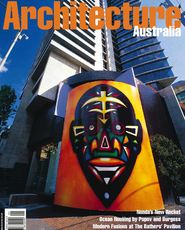Digital technologies are beginning to foster exciting convergences of the previously divorced aural and visual fields of design. Neil McLachlan, working on these issues at RMIT, explores some of the potential for architecture that listens.
|
Early in 1998, Paul Keating made a $10,800 investment in a small company developing computer systems to deliver three-dimensional sound. On 3 December 1999, that company, Lake DSP, listed on the Australian Stock Exchange and Paul Keating’s 10 percent share became worth more than $8 million. 1 The Faculty of the Constructed Environment at RMIT University bought a small Lake system in late 1997. In conjunction with acoustic modelling software, this system enables us to hear a three-dimensional representation of sounds as they would occur at a given position within a digitally modelled architecture. A new word, auralization, has been invented to describe such processes. Auralization is a direct analogy to visualization, which I elaborate upon as the use of visual symbols and perceptual cues (such as lines on a page) to imaginatively construct architecture. Visualization was probably the first design tool and it has been the most dominant mode of design thinking for so long that it has practically become synonymous with all forms of design practice. The explanatory power of visual analogies and visualization seemed so great that the new age of reason following the Renaissance in Europe was called the Age of Enlightenment. In his well-known book, Downcast Eyes: The Denigration of Vision in Twentieth Century French Thought , Martin Jay details how sight came to replace hearing as the dominant sense used in the conveying of symbolic meaning in Western culture. At about the beginning of the Age of Enlightenment, Cartesian perspectivalism extended visualization to an abstracted and disembodied ‘angelic eye’, creating an absolute reference frame against which all else (including the body) is objectified. This disembodied gaze evolved to become a common conceptualization of space as a static Cartesian grid extending infinitely in all directions through a vacuum. It wasn’t until after the publication and experimental verification of Einstein’s Theory of Relativity that the temporality of light itself was understood. Hence time comes to be understood as integral to the act of perceiving itself, and not something that occurs when objects move about within a fixed or existing visually defined field. The speed of sound is about a million times slower than light and so can be directly perceived. During the Age of Enlightenment, the intrinsic transience of sound was not as useful as light for generating absolutist metaphors. Having once been central to some of the earliest known physics (Pythagorean string harmonics and tuning), sound became increasingly marginalized to the domain of musical diversions and scientific curios, up until the present day. During the second half of the twentieth century, the science of psycho-acoustics has detailed how hearing generates a spatial field of sound locations through the perception of the time delays inherent sound transmission. 3 The most obvious of these spatial cues are echoes, which not only tell us the size and position of surfaces around us but also something of their material nature. The direction from which sound waves arrive at the listener’s head are determined by time delays between the ears and from echoes arising within the asymmetrical outer ear and from the shoulders. Like light, sounds also have a frequency spectrum. This adds other perceptual dimensions such as pitch and timbre to the sense of hearing through which most symbolic information is encoded. |
Since hearing is continuous in time and extends in all directions, it is perhaps our most spatial sense. Often in physically crowded environments, acoustic horizons are far wider than visual horizons, and spatial information from sound is determined before visual confirmation. Despite the large technological progress made in the transmission of symbolic information though visual mediums since the printing press, a great deal of our thinking still occurs via our acoustic self; that is, the voice we perceive within us when we read this page. This acoustic self exists in a dynamic relationship with our acoustic environment, and great stress is caused to individuals when environmental noise or distraction overwhelms the acoustic self. The acoustic environment of the developed world is so degraded that we are experiencing a plague of deafness and noise-induced stress. Research from nearly forty years ago (even before the popularity of loud music) revealed that hearing loss is not a direct consequence of aging but (in the absence of physical or pathological injury) is due to environmental factors. 4 New hearing tests developed at the Australian National Acoustic Laboratories predict that by the year 2014, about 78 percent of Australian men will have suffered significant hearing loss. 5 The invention of auralization enables us to engage in spatial design from a new conceptual position and with a wider range of dynamic and embodied imaginative processes. When coupled with the digital visual modelling systems currently available, architecture may become the construction of spatial narratives within virtual realities. A type of digital prototyping that enables the designer and the client to virtually inhabit, and so assess, the visual and acoustic fields is likely to be created by the proposed architecture. Interestingly, while it may be some time before architects are ready to engage with acoustic design processes, the people best suited to work in auralization are those very few people trained in the computer music composition. However, if we are to improve the quality of our lives in the twenty-first century, all designers will need to become familiar with this new tool. Neil McLachlan is an adjunct professor at RMIT’s School of Architecture and Design.
|
||
 |
 |
left: Plan. right: Elevation. Mappings of an array of virtual acoustic images in a computer model of a library, attained using Catt Acoustic software. The position and size of each circle refers to the position and relative amplitude of each virtual source created by reflections of a single incident sound located at the centre of the largest circle.















